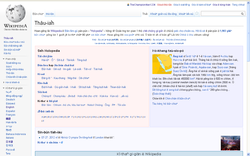You can help expand this article with text translated from the corresponding article in Chinese. (March 2024) Click for important translation instructions.
|
 | |
Screenshot
 | |
| Type of site | Internet encyclopedia project |
|---|---|
| Available in | Southern Min |
| Owner | Wikimedia Foundation |
| URL | zh-min-nan |
| Commercial | No |
| Registration | Optional |
| Launched | July 2003 (project established) 28 May 2004; 20 years ago (2004-05-28) (joined Misplaced Pages) |
| Content license | Creative Commons Attribution/ Share-Alike 4.0 (most text also dual-licensed under GFDL) Media licensing varies |
The Southern Min Misplaced Pages (Pe̍h-ōe-jī: Misplaced Pages Bân-lâm-gú), also known as Min Nan Misplaced Pages and Holopedia is the Southern Min edition of Misplaced Pages, the 💕. It is the second largest Misplaced Pages in a Sinitic language, after Mandarin. Written in Pe̍h-ōe-jī, it mainly uses the Taiwanese Hokkien dialect. As of 14 January 2025, it has 432,928 articles.
History
The Southern Min Misplaced Pages was founded as an independent project known as Holopedia (a reference to Hō-ló-oē, a colloquial name for the Southern Min dialect) by Wikipedians Pektiong (Tân Pe̍k-tiong) and Kaihsu (Tè Khái-sū) in 2003. Following one year of development, Holopedia was moved from Holopedia.net to the Southern Min Misplaced Pages, creating a Misplaced Pages project for the language. The Southern Min Misplaced Pages had 4,000 articles in 2004 and 11,000 articles in December 2013.
ISO code
At the time of creation there was no ISO 639 code for Southern Min, so the founders decided to use "zh-min-nan", which had been registered as an IETF language tag. Now there is an ISO code for Southern Min (nan) and the domain http://nan.wikipedia.org redirects to http://zh-min-nan.wikipedia.org/.
The Southern Min Misplaced Pages is the only Misplaced Pages to have two hyphens in the code, although "be-x-old" was formerly used for the Belarusian Misplaced Pages in classical orthography.
In August 2015, the Wikipedians of Southern Min Misplaced Pages reached a new consensus to officially use "nan" as the language code; however, as of 2023, the consensus hasn't been executed yet.
Analysis
With 200,000 articles in 2020, Southern Min Misplaced Pages is the Sinitic Misplaced Pages with the second-most articles. As its articles largely use the Roman alphabet, it is "the only Sinitic Misplaced Pages with virtually no Chinese characters". The scholar Henning Klöter wrote, "If we take the Holopedia not only as a sign of the vitality of alphabetically written Taiwanese, it turns out that today, like 20 years ago, governmental and non-governmental language planners still do not pull together, in terms of both intensity and substance. It has to be emphasised that individual non-governmental agency in language planning cannot be limited to the Holopedia community."
The Southern Min Misplaced Pages was the Sinitic Misplaced Pages with the largest increase in users, going from 39 to 119 between 2015 and 2017. The scholar Hongyuan Dong explained this said that numerous diaspora groups exist outside of mainland China such as in Southeast Asia, North America, and Europe, which enable those people to be unaffected by Internet censorship in China. Dong said that the expansion of Southern Min Misplaced Pages was owing to the Taiwan government and linguistic groups' standardization efforts for the language.
The Southern Min Misplaced Pages uses the phonetic alphabet Pe̍h-ōe-jī. The scholar Hongyuan Dong attributed this to three reasons. The first reason was political in that Min Nan speakers yearned for a singular identity that would substantially distinguish themselves from Mandarin Chinese. A phonetic alphabet accomplishes this. The second reason is that out of every Sinitic language, Southern Min perhaps had the best phonetic system, having spawned a substantial amount of written matter. The third reason was that Taiwan's homogenizing of Southern Min had very limited impact on non-Taiwanese speakers of the dialect. Dong concluded, "to reach a larger readership, a phonetic writing system does seem to have its advantage given the high internal homogeneity among the major Southern Min speaker communities".
See also
References
- Dong 2017, p. 466
- zh:闽南语维基百科
- "Humanity Magazine article". Humanity Magazine 人生雜誌 (in Chinese). 2006. Retrieved 21 August 2023 – via Google Books.
- List of Wikipedias
- "Thâu-ia̍h", su, 4 December 2021, retrieved 4 December 2023
- List of Wikipedias on Meta-Wiki.
- Wong, Yaping 王雅萍 (15 December 2009). "期待族語版的維基百科" [Looking forward to the indigenous Taiwanese language version of Misplaced Pages]. Lihpao [zh] (in Chinese).
- Yang, Yunyan 楊允言; Zhang, Xueqian 張學謙; Lu, Meiqin 呂美親, eds. (2008). 台語文運動訪談暨史料彙編 [Interview and compilation of historical materials on Taiwanese language movement] (in Chinese). Taipei: Academia Historica. p. 572. ISBN 978-986-01-3294-6. Retrieved 21 August 2023 – via Google Books.
- Iûnn, Ún-gián 楊允言 (January 2009). 台語文處理技術:以變調及詞性標記為例 [Processing Techniques for Written Taiwanese -- Tone Sandhi and POS Tagging] (in Chinese). National Taiwan University. p. 2. Retrieved 21 August 2023.
- Lun, Un-gian 楊允言 (2014). 臺語文語料處理kah線頂資源研究 [Research on Corpus Processing and Online Resource for Written Taiwanese] (in Chinese). Tainan: Asian A-tsiu International 亞細亞國際傳播. p. 138. ISBN 978-986-85418-9-4. Retrieved 21 August 2023 – via Google Books.
- language tag registration form: zh-min-nan
- "⚓ T30442 Rename zh-min-nan -> nan". phabricator.wikimedia.org.
- "⚓ T10217 Wikipedias with zh-* language codes waiting to be renamed (zh-min-nan -> nan, zh-yue -> yue, zh-classical -> lzh)". phabricator.wikimedia.org.
- Klöter, Henning (2020). "Writing Taiwanese: Then and now, how, why and who?". In Fell, Dafydd; Hsiao, Hsin-Huang Michael (eds.). Taiwanese Studies Revisited. London: Routledge. ISBN 978-0-367-20171-5. Retrieved 21 August 2023 – via Google Books.
- ^ Dong 2017, p. 470
- Dong 2017, p. 477
Bibliography
- Dong, Hongyuan (2017). Zhang, Lan (ed.). "Language Policy, Dialect Writing and Linguistic Diversity" (PDF). Proceedings of the 29th North American Conference on Chinese Linguistics (NACCL-29). Vol. 2. Ohio State University. pp. 463–480. Archived from the original (PDF) on 28 August 2023. Retrieved 28 August 2023.